
The share of Russian aluminum stocks in warehouses registered with the London Metal Exchange (LME) climbed to 53% of the total in March, or 220,575 tonnes, from 41% in January, data on the exchange’s website showed on Tuesday.
The data suggests that consumers in industries ranging from transport to construction and packaging continue to shun Russian metal.
“Companies in Europe and in some parts of Asia do not want Russian aluminum. They may have contracts so they will take it, but they will not use it and instead deliver it to the LME,” an aluminum industry source told Reuters.
The world’s oldest exchange and largest market for industrial metals has not banned Russian metals from being traded and stored in its system since Moscow invaded Ukraine, as there are no Western sanctions on Russian base metals.
It, however, suspended the inflow of Russian metal into its US registered warehouses from late February after the United States announced import tariffs on Russian metal.
These US import tariffs have further complicated the use of Russian aluminum produced by Rusal, which already had some self-sanctioning consumers.
Commodity trader Glencore, which has a multi-year contract with Rusal, deposited tens of thousands of tonnes of Russian aluminum in LME-registered warehouses in Asia in recent months, sources with knowledge of the matter have told Reuters.
Glencore said in February that “there is nothing abnormal” about these deliveries and that its contract with Rusal would expire in the second half of 2024.
The rising share of Russian aluminum in warehouses “appears to have happened in a market which faced seasonal oversupply, as indicated by rising inventories (not only on the LME but also along the value chain),” said Julius Baer analyst Carsten Menke.
Overall LME aluminum stocks are up 85% since early September to 512,725 tonnes, inflating the discount for the cash over the three-month aluminum contract to the current $43.5 a tonne.
The LME report also showed that as of March 31, the share of Russian copper stocks fell to 49% from 94% in January, or 22,275 tonnes, while nickel rose to 21% from 16%, or 8,058 tonnes.
(By Polina Devitt and Pratima Desai; Editing by Sharon Singleton)
Comments